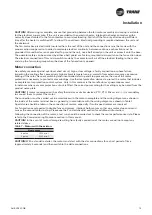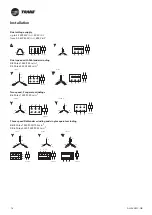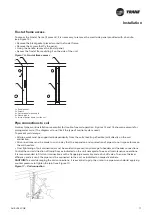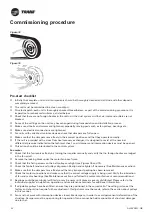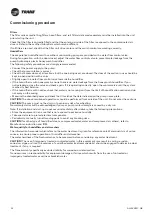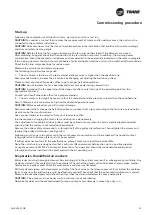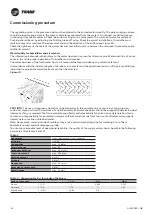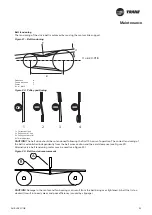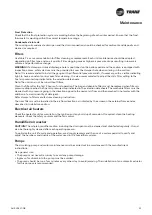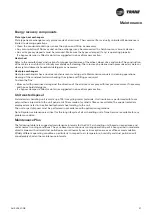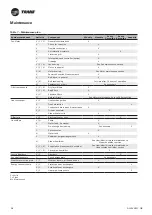
29
11
UNT-PRC002-GB
Sound power levels
Discharge
Measurement conditions:
Measurements taken in a room adjacent to the room containing the FWD, at the outlet of the rectangular duct (1.5 m
long) fixed to its discharge opening.
Fan
Power level in dB(A), per Hz frequency band
Overall power
Unit
speed
125
250
500
1000
2000
4000
8000
dB(A)
1
55
50
42
37
37
31
30
46
FWD 08
2
57
54
47
40
30
38
40
50
3
58
57
50
42
32
40
43
53
1
57
51
45
42
34
33
28
48
FWD 10
2
58
54
48
45
38
39
35
51
3
60
58
50
48
40
42
39
54
1
57
51
45
42
34
33
28
48
FWD 12
2
58
54
48
45
38
39
35
51
3
60
58
50
48
40
42
39
54
1
56
62
50
48
39
38
36
56
FWD 14
2
61
66
55
53
47
46
45
60
3
63
69
58
56
50
50
49
63
1
57
63
51
49
40
39
37
57
FWD 20
2
61
66
55
53
47
46
45
60
3
63
69
58
56
50
50
49
63
Intake
Measurement conditions:
Measurements taken at the horizontal air intake.
Fan
Power level in dB(A), per Hz frequency band
Overall power
Unit
speed
125
250
500
1000
2000
4000
8000
dB(A)
1
56
55
55
53
46
45
42
57
FWD 08
2
63
62
60
60
53
53
53
64
3
66
65
63
62
56
55
57
67
1
62
58
55
58
51
48
44
61
FWD 10
2
66
63
60
62
56
55
52
66
3
70
67
63
65
59
59
57
69
1
62
58
55
58
51
48
44
61
FWD 12
2
66
63
60
62
56
55
52
66
3
70
67
63
65
59
59
57
69
1
66
65
65
65
57
50
46
68
FWD 14
2
73
72
69
71
64
59
57
74
3
78
76
73
75
69
64
63
78
1
68
72
64
64
56
52
50
69
FWD 20
2
76
76
68
71
65
61
61
75
3
78
79
71
74
69
66
66
78
AH-SVX03C-GB
Trouble analysis
This section contains information about the following:
• Unit control problems.
• Symptoms, probable causes, and recommended actions.
Note:
Refer to the unit Installation and Operation Manual for AHU unit trouble analysis and other information on
electrical connection. Use the tables in this section to assist in identifying the cause or causes of a malfunction in
the unit controls. The column header 'Recommended Action' suggests repair procedures. Some problems may be
caused by software and operator screen settings. These tables are intended as a diagnostic aid only. For detailed
repair procedures, contact your local Trane office.
WARNING! Hazardous Voltage with Capacitors!
Disconnect all energy sources, including remote disconnects, and discharge all capacitors before servicing.
Follow proper lockout/tagout procedures to ensure the power cannot be inadvertently energized.
After power is off, allow five minutes for all motor or compressor start or run capacitors to discharge.
For Trane provided variable frequency drives wait 20 minutes.
For other manufacturer's variable frequency drives or energy storing components, refer to the appropriate
manufacturer's literature for allowable waiting periods for discharge of capacitors. Verify with an appropriate
voltmeter that all capacitors are discharged. Failure to disconnect power and/or discharge capacitors before servicing
could result in death or serious injury.
Note:
For additional information regarding the safe discharge of capacitors, see PROD-SVB06A-EN or
PROD-SVB06A-FR.
WARNING!:
Disconnect all energy sources and allow all rotating equipment to stop completely. Allow hot and cool
surfaces enough time to reach safe surface temperatures before inspecting or servicing the unit. Failure to do so may
result in personal injury or death from electrical shock or moving parts.
WARNING!:
Disconnect all energy sources prior to access fan sections or ductwork. Even when locked out
electrically, fans may cause injury or damage if the impeller is subject to 'wind-milling'. The impeller should be
secured to physically restrict rotational movement.
Failure to secure the impeller could cause severe personal injury or death.
Variable Frequency Drives
Variable Frequency Drives (VFD) are used more and more often to control fan speeds in order to optimize the
operation and the energy consumption of the units.
When VFDs are provided and installed by other non-Trane suppliers on site, please follow these specific
recommendations to ensure correct and safe operation.
1. The VFD must be compatible with HVAC applications, such as fans with quadratic torque.
2. The electric power output of the VFD shall be compatible with the nominal power of the motor.
3. The VFD shall be compatible with its environment (IP rate, type of ventilation, ambient temperature,
electromagnetic environment…)
4. All recommendations indicated in the Installation/Operation/Maintenance manual of the VFD manufacturer must
be respected.
Although the use of VFDs does not create any problem, some undesirable phenomena can occurs : vibration,
excessive noise, lower efficiencies, motor overheating…
You can easily check if these problems come from the VFD by connecting the motor directly to the main supply. Most
of the VFD drives available on the market include some specific functions to allow them to overcome these kinds of
problems.
In all cases, read the VFD manual carefully and if necessary contact your local Trane sales office.
Factory engineered controls

